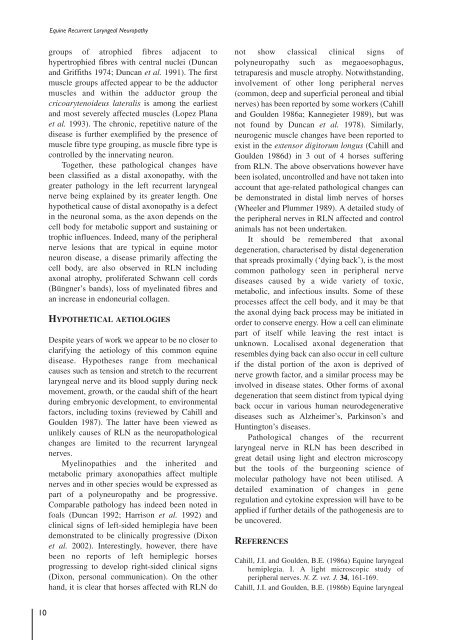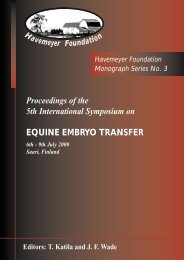Proceedings of a Workshop on - The Havemeyer Foundation
Proceedings of a Workshop on - The Havemeyer Foundation
Proceedings of a Workshop on - The Havemeyer Foundation
Create successful ePaper yourself
Turn your PDF publications into a flip-book with our unique Google optimized e-Paper software.
Equine Recurrent Laryngeal Neuropathy<br />
groups <str<strong>on</strong>g>of</str<strong>on</strong>g> atrophied fibres adjacent to<br />
hypertrophied fibres with central nuclei (Duncan<br />
and Griffiths 1974; Duncan et al. 1991). <strong>The</strong> first<br />
muscle groups affected appear to be the adductor<br />
muscles and within the adductor group the<br />
cricoarytenoideus lateralis is am<strong>on</strong>g the earliest<br />
and most severely affected muscles (Lopez Plana<br />
et al. 1993). <strong>The</strong> chr<strong>on</strong>ic, repetitive nature <str<strong>on</strong>g>of</str<strong>on</strong>g> the<br />
disease is further exemplified by the presence <str<strong>on</strong>g>of</str<strong>on</strong>g><br />
muscle fibre type grouping, as muscle fibre type is<br />
c<strong>on</strong>trolled by the innervating neur<strong>on</strong>.<br />
Together, these pathological changes have<br />
been classified as a distal ax<strong>on</strong>opathy, with the<br />
greater pathology in the left recurrent laryngeal<br />
nerve being explained by its greater length. One<br />
hypothetical cause <str<strong>on</strong>g>of</str<strong>on</strong>g> distal ax<strong>on</strong>opathy is a defect<br />
in the neur<strong>on</strong>al soma, as the ax<strong>on</strong> depends <strong>on</strong> the<br />
cell body for metabolic support and sustaining or<br />
trophic influences. Indeed, many <str<strong>on</strong>g>of</str<strong>on</strong>g> the peripheral<br />
nerve lesi<strong>on</strong>s that are typical in equine motor<br />
neur<strong>on</strong> disease, a disease primarily affecting the<br />
cell body, are also observed in RLN including<br />
ax<strong>on</strong>al atrophy, proliferated Schwann cell cords<br />
(Büngner’s bands), loss <str<strong>on</strong>g>of</str<strong>on</strong>g> myelinated fibres and<br />
an increase in end<strong>on</strong>eurial collagen.<br />
HYPOTHETICAL AETIOLOGIES<br />
Despite years <str<strong>on</strong>g>of</str<strong>on</strong>g> work we appear to be no closer to<br />
clarifying the aetiology <str<strong>on</strong>g>of</str<strong>on</strong>g> this comm<strong>on</strong> equine<br />
disease. Hypotheses range from mechanical<br />
causes such as tensi<strong>on</strong> and stretch to the recurrent<br />
laryngeal nerve and its blood supply during neck<br />
movement, growth, or the caudal shift <str<strong>on</strong>g>of</str<strong>on</strong>g> the heart<br />
during embry<strong>on</strong>ic development, to envir<strong>on</strong>mental<br />
factors, including toxins (reviewed by Cahill and<br />
Goulden 1987). <strong>The</strong> latter have been viewed as<br />
unlikely causes <str<strong>on</strong>g>of</str<strong>on</strong>g> RLN as the neuropathological<br />
changes are limited to the recurrent laryngeal<br />
nerves.<br />
Myelinopathies and the inherited and<br />
metabolic primary ax<strong>on</strong>opathies affect multiple<br />
nerves and in other species would be expressed as<br />
part <str<strong>on</strong>g>of</str<strong>on</strong>g> a polyneuropathy and be progressive.<br />
Comparable pathology has indeed been noted in<br />
foals (Duncan 1992; Harris<strong>on</strong> et al. 1992) and<br />
clinical signs <str<strong>on</strong>g>of</str<strong>on</strong>g> left-sided hemiplegia have been<br />
dem<strong>on</strong>strated to be clinically progressive (Dix<strong>on</strong><br />
et al. 2002). Interestingly, however, there have<br />
been no reports <str<strong>on</strong>g>of</str<strong>on</strong>g> left hemiplegic horses<br />
progressing to develop right-sided clinical signs<br />
(Dix<strong>on</strong>, pers<strong>on</strong>al communicati<strong>on</strong>). On the other<br />
hand, it is clear that horses affected with RLN do<br />
not show classical clinical signs <str<strong>on</strong>g>of</str<strong>on</strong>g><br />
polyneuropathy such as megaoesophagus,<br />
tetraparesis and muscle atrophy. Notwithstanding,<br />
involvement <str<strong>on</strong>g>of</str<strong>on</strong>g> other l<strong>on</strong>g peripheral nerves<br />
(comm<strong>on</strong>, deep and superficial per<strong>on</strong>eal and tibial<br />
nerves) has been reported by some workers (Cahill<br />
and Goulden 1986a; Kannegieter 1989), but was<br />
not found by Duncan et al. 1978). Similarly,<br />
neurogenic muscle changes have been reported to<br />
exist in the extensor digitorum l<strong>on</strong>gus (Cahill and<br />
Goulden 1986d) in 3 out <str<strong>on</strong>g>of</str<strong>on</strong>g> 4 horses suffering<br />
from RLN. <strong>The</strong> above observati<strong>on</strong>s however have<br />
been isolated, unc<strong>on</strong>trolled and have not taken into<br />
account that age-related pathological changes can<br />
be dem<strong>on</strong>strated in distal limb nerves <str<strong>on</strong>g>of</str<strong>on</strong>g> horses<br />
(Wheeler and Plummer 1989). A detailed study <str<strong>on</strong>g>of</str<strong>on</strong>g><br />
the peripheral nerves in RLN affected and c<strong>on</strong>trol<br />
animals has not been undertaken.<br />
It should be remembered that ax<strong>on</strong>al<br />
degenerati<strong>on</strong>, characterised by distal degenerati<strong>on</strong><br />
that spreads proximally (‘dying back’), is the most<br />
comm<strong>on</strong> pathology seen in peripheral nerve<br />
diseases caused by a wide variety <str<strong>on</strong>g>of</str<strong>on</strong>g> toxic,<br />
metabolic, and infectious insults. Some <str<strong>on</strong>g>of</str<strong>on</strong>g> these<br />
processes affect the cell body, and it may be that<br />
the ax<strong>on</strong>al dying back process may be initiated in<br />
order to c<strong>on</strong>serve energy. How a cell can eliminate<br />
part <str<strong>on</strong>g>of</str<strong>on</strong>g> itself while leaving the rest intact is<br />
unknown. Localised ax<strong>on</strong>al degenerati<strong>on</strong> that<br />
resembles dying back can also occur in cell culture<br />
if the distal porti<strong>on</strong> <str<strong>on</strong>g>of</str<strong>on</strong>g> the ax<strong>on</strong> is deprived <str<strong>on</strong>g>of</str<strong>on</strong>g><br />
nerve growth factor, and a similar process may be<br />
involved in disease states. Other forms <str<strong>on</strong>g>of</str<strong>on</strong>g> ax<strong>on</strong>al<br />
degenerati<strong>on</strong> that seem distinct from typical dying<br />
back occur in various human neurodegenerative<br />
diseases such as Alzheimer’s, Parkins<strong>on</strong>’s and<br />
Huntingt<strong>on</strong>’s diseases.<br />
Pathological changes <str<strong>on</strong>g>of</str<strong>on</strong>g> the recurrent<br />
laryngeal nerve in RLN has been described in<br />
great detail using light and electr<strong>on</strong> microscopy<br />
but the tools <str<strong>on</strong>g>of</str<strong>on</strong>g> the burge<strong>on</strong>ing science <str<strong>on</strong>g>of</str<strong>on</strong>g><br />
molecular pathology have not been utilised. A<br />
detailed examinati<strong>on</strong> <str<strong>on</strong>g>of</str<strong>on</strong>g> changes in gene<br />
regulati<strong>on</strong> and cytokine expressi<strong>on</strong> will have to be<br />
applied if further details <str<strong>on</strong>g>of</str<strong>on</strong>g> the pathogenesis are to<br />
be uncovered.<br />
REFERENCES<br />
Cahill, J.I. and Goulden, B.E. (1986a) Equine laryngeal<br />
hemiplegia. I. A light microscopic study <str<strong>on</strong>g>of</str<strong>on</strong>g><br />
peripheral nerves. N. Z. vet. J. 34, 161-169.<br />
Cahill, J.I. and Goulden, B.E. (1986b) Equine laryngeal<br />
10








